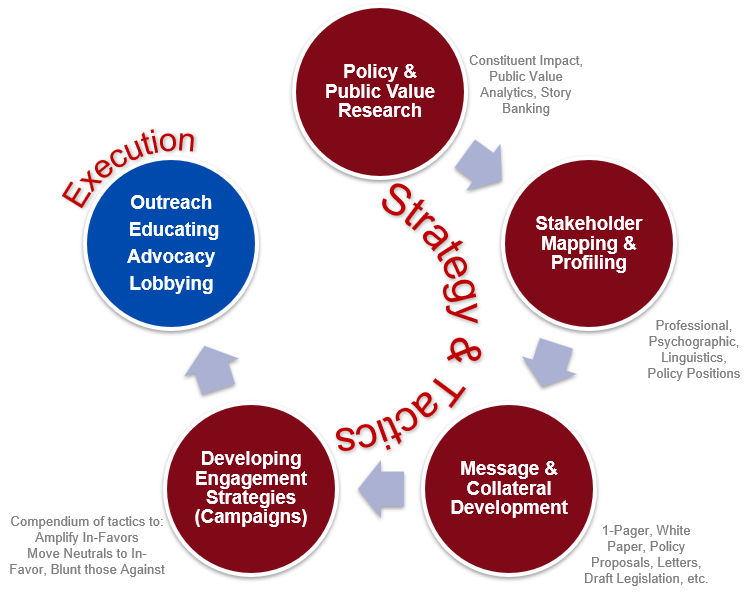
Structured Advocacy Framework Pillar: All
Structured Advocacy Framework
SAF best-practice framework offers a clear, step-by-step guide to help you elevate the public value of your proposals. The ultimate goal of any advocacy process is to win the hearts and minds of policymakers. Policymakers are most persuaded by public value persepctives revolving around: government efficiency, innovation, economic impact, social benefit, and sustainability. Government Analytica brings more than 30 years of experience and thousands of projects across the United States and 40+ countries to advise clients helping you with your strategy.
CITATION: Structured Advocacy Framework, Government Analytica. More on Government Analytica's Structured Advocacy Framework (SAF). IP: All content is the intellectual property of Government Analytica governed by its Intellectual Property and Use Policy.
Turning Government Advocacy into Clarity and Impact
Government advocacy should not be a mystery reserved for insiders. Too often, it is portrayed as an art dependent on relationships or secretive approaches. In reality, effective advocacy is rooted in preparation, clarity, and evidence. Citizens, nonprofits, associations, and companies can all engage government when armed with the right framework and a compelling story.
Elected and appointed officials welcome well-prepared outreach. They want to hear from the people affected by their decisions. What they often lack is the full context, data, and analysis necessary to make sound choices on the flood of issues before them.
True advocacy is not only about knowing what you want. It is also about respectfully understanding the public value perception of those you engage—decision-makers, influencers, and the broader community. When you frame your asks so they connect with their priorities and worldview, you transform your proposal from a private interest into a public good.
This is where Government Analytica comes in. We simplify the complexity of advocacy by giving you a proven, evidence-based process. Our Structured Advocacy Framework™ (depicted below) equips you with clarity, strategy, and tools to influence effectively. Through our 6-Step playbook, we transform your proposals into compelling narratives, tactical actions, aligned with key stakeholders and rooted in public value—narratives that resonate with government leaders and drive real results.

1. Public Policy Research
Government research is the process of collecting, organizing, , analyzing, and extracting insights that allows strategic decisions to be made and proposals created on topics of interest to government. At Government Analytica we use a methodology called OSINT, or Open-Source Intelligence. Research in this step is where we familiarize ourselves with perception of public value for our key stakeholders. STakeholder profiles are key to winning campaigns.
- There are six main sources for such open source intelligence gathering.
- Our tools and techniques are available for training those interested in practicing these approaches.
- Alternatively, Government Analytica can perform this type of research for clients as a contracted consulting service.

2. Public Value Propositions
Public value describes the positive impact that an organization or activity brings to society. Within government circles, it can be described in a proposal, policy briefs, 1-pagers, white papers, proposed bills, in regulatory input, and many other forms input to government.
- Government officials, elected or appointed, respond favorably in supporting proposals of public value.
- However public value is in the eye of the beholder (i.e. policymaker)
- Therefore, it is necessary to understand and profile stakeholders to understand what the target audience's perception of "high public value" is.
Government Analytica's core competence is development of public value propositions especially layered with unique tools and analytics to develop a custom narrative for that policy maker and win their hearts and minds.

3. Stakeholder Maps
Well-articulated proposals inspire policy makers into action. So, who are these policymakers you have to reach out to? Research identifies these key stakeholders. In Government, regardless of country or political system, they are in one of 3 clusters:
- Members of the Executive Branch: President and their cabinet and staff at the federal level, Governors and their commissioners and staff at the state level, County Commissioners and their staff, and finally mayors, and their staff.
- Members of the legislative Branch: Members of congress or parliaments at the federal/national level, legislature at the state level, and city council members at the municipal level.
- Peer/Pressure Groups: Any non-governmental organization that can create public pressure is important to map. These are often associations, non-profits, media, academia, companies, businesses, and citizen groups. They can be local, regional, national, or international in reach and scope.
Government Analytica's 3-by-3 Stakeholder Map enables the design and choreography of a playbook that will create a successful campaigns.


4. Public Policy Proposals
You must take your value proposition to your stakeholders in the form of a well-written proposal. Enrich your pitch with a good proposals:
- Acknowledge and are aligned with the policy makers public value drivers.
- Demonstrate why the proposer is ideally suited to offer a solution.
- Describes a solution/offer/ask and frames its public value to stakeholder in their language.
- Pitch the proposal with a rousing call to action.
If a proposal contains data and analytics, the odds of conversion of a neutral stakeholder to a supporter of the proposal increases significantly. Government Analytica has templates, techniques, and even the analytical ability to turn a qualitative proposal into a data driven public value pitch.

5. Stakeholder Engagement
With a well-researched, well thought out proposal solidly anchored in great public value offerings matching the policymakers' expectations, you can now engage with them well prepped. You can choose from a menu of two-dozen techniques and tactics. Each is well suited for a particular outcome. We focus on the influential individuals, agencies and organizations identified in the Stake Holder Map of Step 3. These meetings are choreographed to :
- Amplify the voice of those in-favor of your proposal.
- Move those neutral about it into the in-favor column.
- Minimize the impact of those who are against your proposal.
Government Analytica uses a slate of tools, techniques, and tactics to make sure your public value story is faithfully transmitted to key stakeholders increasing the odds of inspiring them into action.

6. Conversion
Ultimately all of this effort is to achieve a change in policy, approach, funding, or some other action that the proposer believes will bring greater good to the community. To do so effectively, a continuous count of those in favor must be made to assure the proposer meets the minimum threshold to convince enough people to support the proposal. A tracking system tied to the stakeholder map creates a KPI dashboard to gauge progress and conversion of as many people as possible to in-favor supporters. In tandem a Storybanking System tracks impact stories so they can be used in advocacy.

